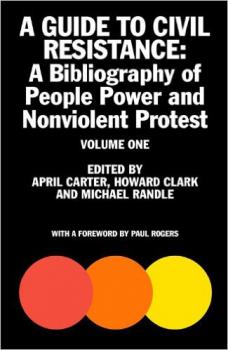 From the first recorded strike in human history (by Egyptian artisans in 1170 BCE) to a successful sex strike by Colombian women in 2011 (‘No more sex. We want our road’), civil resistance – ‘collective action for political or social ends without any systematic recourse to violence’ – has had a long and varied history.
From the first recorded strike in human history (by Egyptian artisans in 1170 BCE) to a successful sex strike by Colombian women in 2011 (‘No more sex. We want our road’), civil resistance – ‘collective action for political or social ends without any systematic recourse to violence’ – has had a long and varied history.
It also looks set to have a long and varied future. Indeed, according to the authors of these books, there has been a greater tendency in recent decades for popular campaigns to use the methods of nonviolent action to try and achieve their ends.
Focusing mainly on the post-war period, and surveying over 1,700 books and articles, these two volumes – an expanded and updated version of an earlier single-volume work published in 2006 – provide an indispensable research guide for anyone wanting to explore the potential of nonviolent action for creating social change. (Indeed, the original single-volume was used for precisely this purpose by Erica Chenoweth in her groundbreaking work on the relative efficacy of violent and nonviolent struggles during the 20th century – see PN 2547–2548).
Written by academics with extensive activist histories of their own, the focus is ‘on protest and resistance, rather than on nonviolence as a philosophy, a social, economic and political theory or as a personal way of life’. Social movements of any size and scope are rarely pure, and the authors have included campaigns if ‘the primary emphasis is on the use of nonviolent (though potentially coercive) methods’, drawing a useful distinction between nonviolent resistance (involving a positive commitment to eschew violence) and unarmed resistance (which simply refrains, in practice, from using lethal weapons). After a brief survey of some classic works on nonviolence (Tolstoy, Thoreau, Bart de Ligt etc...), and a survey of the literature on Gandhi, the US civil rights movement, and nonviolent social defence, volume 1 focusses mainly on ‘people power’: the use of civil resistance to resist colonialism, dictatorship, authoriarianism and military rule. It closes with a brief look at the literature debating the nature and politics of ‘external assistance’ to nonviolent movements. (The authors conclude, reasonably in my opinion, that ‘although external government agencies may be able to fund and encourage protest, widespread involvement suggests genuine and deep popular grievances’.)
After a brief survey of some classic works on nonviolence (Tolstoy, Thoreau, Bart de Ligt etc...), and a survey of the literature on Gandhi, the US civil rights movement, and nonviolent social defence, volume 1 focusses mainly on ‘people power’: the use of civil resistance to resist colonialism, dictatorship, authoriarianism and military rule. It closes with a brief look at the literature debating the nature and politics of ‘external assistance’ to nonviolent movements. (The authors conclude, reasonably in my opinion, that ‘although external government agencies may be able to fund and encourage protest, widespread involvement suggests genuine and deep popular grievances’.)
Volume 2, a stand-alone work with the stated aim of ‘provid[ing] an introduction to the history of major social movements’, may be of more interest to UK activists, who don’t get many opportunities to overthrow dictators (though they may want to start thinking about how to resist a military coup if Jeremy Corbyn looks like he has any chance of winning the next election).
Though it includes a global dimension – giving weight to movements since 2010, and devoting a chapter to resistance by indigenous peoples – an acknowledged emphasis has been placed on peace, green, feminist and LGBT campaigns in the UK, with a particular focus on Northern Ireland.
Some bibliographies are pure delights, to which one returns repeatedly for inspiration and to find new gems (the bibliography in Douglas Hofstadter’s Metamagical Themas springs to mind). Others are dry works of reference. These two volumes fall somewhere in between these two poles.
The introductions to each section are useful and lucid, and I certainly learned new things and encountered titles that I will be chasing up. On the other hand, a significant number of the entries have no commentary at all, while others seem like missed opportunities (to be told that Taylor Branch’s epic, award-winning works on ‘America in the King years’ – which together total over 2,800 pages – are a ‘trilogy’ and a ‘readable narrative’ doesn’t really tell one very much).
Of necessity, much has had to be left out, but I particularly regretted the omission of a section on
books critiquing nonviolence (eg Ward Churchill’s infamous Pacifism as Pathology) and responses to these critiques (such as George Lakey’s The Sword that Heals).
The full text of volume 1 is already available online in a fully searchable form at civilresistance.info, and volume 2 should be following it shortly. Hopefully this will help to give these works the wide audience that they deserve.
Topics: Violence & nonviolence


